Feel free to email us using the form at the end of this page or via our contact us page for advice on pear pests and diseases. Also, please see our question and answer section on pear tree problems at the end of this article. Your question may already have been answered there.
YOUNG FRUITS FALL OFF, BASE OF FRUIT IS BLACK
This is almost certainly Pear Midge damage. To confirm it cut open affected young fruit and you will find small, cream-coloured maggots inside (see above).
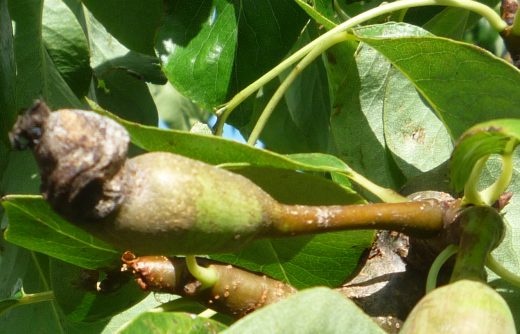

Pear Midge damage to fruit
This pest can affect single pear trees whereas other nearby trees are completely unaffected. Affected fruit initially appears to grow larger and “rounder” than other fruit. Read our dedicated article on identifying and treating Pear Tree Midge here.
DISEASED AND SUNKEN AREAS OF BARK
If you can see a diseased area of bark on your tree then suspect canker especially if it is where a branch has previously been pruned. The bark will be split and slightly sunken at first – the sunken area will become larger as the disease progresses. The disease attacks the fleshy wood beneath the bark first so if you peel off a small bit of bark and see brown diseased wood below then your tree has canker. Canker often appears as ring-shaped cracks in the bark. Click here for full information on identifying, treating and preventing canker on pear trees.
YELLOW / OLIVE AREAS ON LEAVES
Scab not only affects the leaves of pear trees it also affects the fruit. As well as yellow and dark green / black spots on the underside and top of leaves you may also see groups of the spores growing as small brown velvety mounds on the underside of leaves. Go to our dedicated scab page for treatment and prevention methods.


Leaf affected by Scab
BLACKENED BLOSSOM AND NEW SHOOTS
The symptoms of fireblight are hard to miss even at the initial stages of infection. First the blossoms are infected then new shoots, fruit and finally the main branches can be affected. The key symptoms are ….. Click here for lots more expert information on identifying and treating fire blight on pear trees.
APHIDS – SMALL INSECTS ON LEAVES
The above picture shows aphids on a blackcurrant leaf but they look exactly the same on a pear tree leaf. Aphids first attack the undersides of leaves and this causes them to curl inwards on themselves. If left untreated the leaves will turn brown at the edges. Read our article on aphids here for expert advice on treating aphids both with chemical sprays and organically.
SMALL BLACK LEECHES / SLUGS ON LEAVES
This is the Pear Slug Sawfly (Caliroa cerasi). It affects pear, cherry and apple trees as well as some ornamental shrubs, hawthorns in particular. On fruit trees, the black leech like creatures are in fact green but covered with black slime. The slime is a protection mechanism to avoid being eaten by birds.
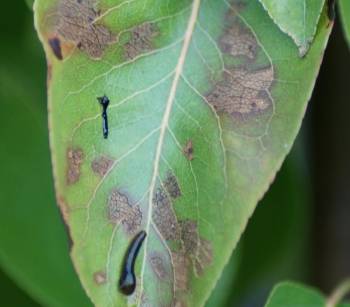

Pear Slug Sawfly (click to enlarge)
The lifecycle of the Pear Slug Sawfly starts with the pupae overwintering in the soil beneath the tree. In spring the actual sawflies emerge and lay eggs on the leaves. The eggs then hatch into the leech like creatures.
It is this slug / leech like stage which does the damage. They feed on the upper surfaces of the leaves with their black slime making them very unattractive to birds. The picture above shows the leaf damage very clearly, it is almost always restricted to the top surface of the leaf.
The larvae feed for three to four weeks and then fall off onto the ground. They will then hatch into a second generation within the same year and it is this second generation which does the significant damage. This normally occurs in late August to mid September.
In severe cases they can damage a huge amount of leaves. They are rarely fatal to the tree and fruit production is normally unaffected because the damage occurs so late in the year. They do make the leaves very unsightly however and can cause problems for already weak trees.
Removing them by hand and disposing of them is one solution but the size of many fruit trees makes this a difficult task. They can be knocked off with a strong jet of water. Spraying with a contact insecticide such as Bifenthrin was the most common treatment but in the UK this insecticide is no longer permitted for amateur gardeners.
Scotts Bug Clear is the recommended alternative but there is little hard evidence for how effective it is with the Pear Slug Sawfly.
EMERGING PEAR LEAVES HAVE SMALL GREEN / PINK / RED BLISTERS
When the leaves start to form in spring they have tiny, slightly raised blisters on them which are normally a pink / green colour. As the leaves develop the blisters deepen in colour to dark red turning to black or deep brown. Some leaves may be totally unaffected but this is very variable. These leaf marks are caused by Pear Leaf Blister Mites.
The picture above shows the early stages of the mite infection. The marks will eventually turn to dark red / brown / black (see picture below). In advanced cases of this disease the fruit can also become deformed although this is unusual. Although the leaves can appear to be very damaged, fruit production is not significantly affected.
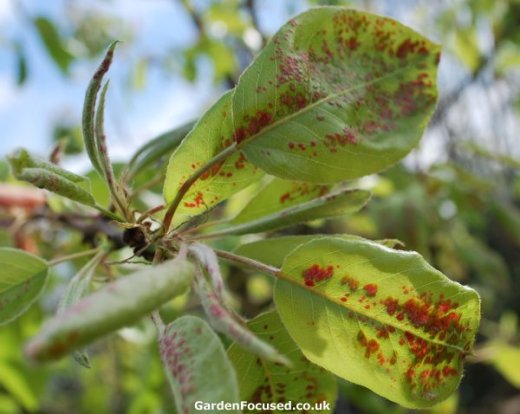

Later stages of Pear Leaf Blister Mite
HOW TO TREAT PEAR LEAF BLISTER MITES
Once you notice damaged leaves it’s impossible kill the existing midges which because they are protected by the surface of the affected leaves. Treatment consists of limiting the damage in the current year and spraying in winter to prevent damage the next year. We recommend the following course of action:
- Prompt action is essential to reduce damage in the current year. Pick off as many damaged leaves as possible to reduce the number of new mites – this pest has several lifecycles within a season. If the damage has been left until until the majority of leaves are affected then skip this step and continue to the next. Stripping off all the leaves will do more damage than good.
- The weak point in the lifecycle (see below) of this mite is during the winter when the adults hibernate either very near the surface of buds or in the joints between bud and stem. Spraying with a winter tree wash (available online and at garden centres) in November / December may well kill most of the mites.
- The Pear Leaf Blister Mites are far more active on trees which are under stress. Lack of water is often at the root of the problem so water well in dry conditions. Apply a long-lasting fertiliser such as blood, fish and bone in March.
LIFE CYCLE OF PEAR LEAF BLISTER MITES
The diagram below is a graphical representation of the life cycle of the Pear Tree Blister Mite
The following is a step by step description of the Pear Leaf Blister Mite life cycle. This pest has two or more generations of adults each year depending on weather conditions:
- Overwinter adults begin to burrow into developing leaf buds in spring when the weather warms up. They are roughly 0.20mm long and invisible to the naked eye.
- Each adult lays about 15 eggs which feed on the leaf tissue. This causes a blister to form which effectively protects from any chemical sprays.
- The centre of the blister breaks allowing mites in and out but in truth they move very little, they just feed!
- Normally there are three or so generations every year. The assumption is, although there is no proof, that the mites are spread from tree to tree by insects or birds.
- When the weather cools in September the adults seek out buds which will develop the next year. They overwinter at the base of the buds or just inside the first layer.
HOLES IN FRUIT
This section is courtesy of George Tondryk who spent hours examining video footage to determine the cause of holes in his pears. See the picture below for an example of the damage.
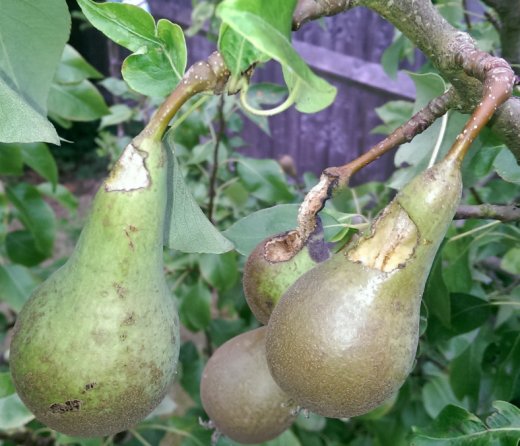
George sent me the relevant section of his video and it shows Blue Tits flying onto the fruits and pecking holes in them. Once the damage is done the holes may well have been enlarged by wasps and other insects but it’s clear from the video that the Blur Tits caused the initial damage.
With bird damage there are only two solutions, either net the fruit or grow them in fruit cages. Nothing else that I am aware of will work.
ORANGE SPOTS ON LEAVES – PEAR RUST
Where you see orange marks on the upper surface of the leaves combined with blisters and small growths on the lower surface this is a sure sign of Pear Rust. Less frequently it can cause smaller orange marks on the fruits. The Latin technical name for this fungal infection is Gymnosporangium sabinae.


Pear Rust on leaf top
The picture above shows the upper side of a leaf infected with Pear Rust. If you turn the leaf over you will also see the blistering which looks almost like little caterpillar legs with black dots in the centre – see picture below.
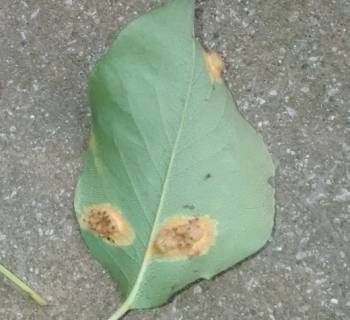

Pear Rust on leaf underside
The first point to note about pear rust is that there are no longer any chemical sprays available to UK gardeners to combat it. The two chemicals which were previously available have now been withdrawn. There are no pear tree varieties which are resistant to this infection
The life cycle of pear rust can hold a cure to its control. In autumn, as the leaves of pear trees are dying, spores are released from the rust infection into the air. If they are to survive winter they must find another plant which retains its leaves over winter. The rust spores in the UK have developed so that they are able to survive on juniper trees and bushes.
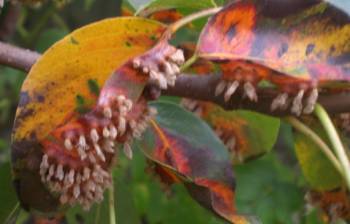

Severe case of Pear Rust
When the spores land on the juniper leaves they over-winter and spores are then again released in May / June time which blow onto pear trees and re-infect them.
One sure fire way to stop the infection spreading, and effectively kill it off, is to remove all juniper trees within a certain radius of the pear trees – half a mile should be more than sufficient. This is often not possible because the juniper bushes are growing on neighbour’s land.
Other than the above there is no method currently available to eradicate pear rust. The only alternatives are to reduce the level of infection and / or keep the pear trees healthy enough to withstand the leaf damage.
Where the infection is noticed early in the year, remove any leaves showing signs of damage which will help reduce the spread of the spores. If the tree is badly infected it’s best to leave the tree to its own devices. Removing large numbers of leaves will weaken it significantly.
General care of your pear tree as explained here will help it survive an attack. Occasionally, where the attack is severe, damage will also occur to branches and will cause cankers. These can allow the spores to overwinter on the pear tree without the need for juniper trees. These cankers should be cut out as described here.
Sometimes our readers ask specific questions which are not covered in the main article above. Our
Pear tree pest and disease comment / question and answer page
lists their comments, questions and answers. At the end of that page there is also a form for you to submit any new question or comment you have.
Rootstocks and Size
Guide to Pollination
Planting
Care Plan
Pruning Pear Trees
Harvest and Storage
Pests and Disease
Top ten pear varieties
Buying – Price Comparison
GUIDE TO PEAR TREE PEST AND DISEASE
By David Marks
Pear trees are generally easier to manage as far as pests and diseases are concerned compared to apple, plum and cherry trees. But there is no doubt they can suffer from a couple of very serious pests, pear midge being the most common and probably the most difficult to eradicate.
This article explores all the common pests and diseases which may affect your pear tree. Most of the problem areas have pictures to clearly illustrate the damage caused which helps to identify the pest / disease.
Feel free to email us using the form at the end of this page or via our contact us page for advice on pear pests and diseases. Also, please see our question and answer section on pear tree problems at the end of this article. Your question may already have been answered there.
YOUNG FRUITS FALL OFF, BASE OF FRUIT IS BLACK
This is almost certainly Pear Midge damage. To confirm it cut open affected young fruit and you will find small, cream-coloured maggots inside (see above).
Pear Midge damage to fruit
This pest can affect single pear trees whereas other nearby trees are completely unaffected. Affected fruit initially appears to grow larger and “rounder” than other fruit. Read our dedicated article on identifying and treating Pear Tree Midge here.
DISEASED AND SUNKEN AREAS OF BARK
If you can see a diseased area of bark on your tree then suspect canker especially if it is where a branch has previously been pruned. The bark will be split and slightly sunken at first – the sunken area will become larger as the disease progresses. The disease attacks the fleshy wood beneath the bark first so if you peel off a small bit of bark and see brown diseased wood below then your tree has canker. Canker often appears as ring-shaped cracks in the bark. Click here for full information on identifying, treating and preventing canker on pear trees.
YELLOW / OLIVE AREAS ON LEAVES
Scab not only affects the leaves of pear trees it also affects the fruit. As well as yellow and dark green / black spots on the underside and top of leaves you may also see groups of the spores growing as small brown velvety mounds on the underside of leaves. Go to our dedicated scab page for treatment and prevention methods.
Leaf affected by Scab
BLACKENED BLOSSOM AND NEW SHOOTS
The symptoms of fireblight are hard to miss even at the initial stages of infection. First the blossoms are infected then new shoots, fruit and finally the main branches can be affected. The key symptoms are ….. Click here for lots more expert information on identifying and treating fire blight on pear trees.
APHIDS – SMALL INSECTS ON LEAVES
The above picture shows aphids on a blackcurrant leaf but they look exactly the same on a pear tree leaf. Aphids first attack the undersides of leaves and this causes them to curl inwards on themselves. If left untreated the leaves will turn brown at the edges. Read our article on aphids here for expert advice on treating aphids both with chemical sprays and organically.
SMALL BLACK LEECHES / SLUGS ON LEAVES
This is the Pear Slug Sawfly (Caliroa cerasi). It affects pear, cherry and apple trees as well as some ornamental shrubs, hawthorns in particular. On fruit trees, the black leech like creatures are in fact green but covered with black slime. The slime is a protection mechanism to avoid being eaten by birds.
Pear Slug Sawfly (click to enlarge)
The lifecycle of the Pear Slug Sawfly starts with the pupae overwintering in the soil beneath the tree. In spring the actual sawflies emerge and lay eggs on the leaves. The eggs then hatch into the leech like creatures.
It is this slug / leech like stage which does the damage. They feed on the upper surfaces of the leaves with their black slime making them very unattractive to birds. The picture above shows the leaf damage very clearly, it is almost always restricted to the top surface of the leaf.
The larvae feed for three to four weeks and then fall off onto the ground. They will then hatch into a second generation within the same year and it is this second generation which does the significant damage. This normally occurs in late August to mid September.
In severe cases they can damage a huge amount of leaves. They are rarely fatal to the tree and fruit production is normally unaffected because the damage occurs so late in the year. They do make the leaves very unsightly however and can cause problems for already weak trees.
Removing them by hand and disposing of them is one solution but the size of many fruit trees makes this a difficult task. They can be knocked off with a strong jet of water. Spraying with a contact insecticide such as Bifenthrin was the most common treatment but in the UK this insecticide is no longer permitted for amateur gardeners.
Scotts Bug Clear is the recommended alternative but there is little hard evidence for how effective it is with the Pear Slug Sawfly.
EMERGING PEAR LEAVES HAVE SMALL GREEN / PINK / RED BLISTERS
When the leaves start to form in spring they have tiny, slightly raised blisters on them which are normally a pink / green colour. As the leaves develop the blisters deepen in colour to dark red turning to black or deep brown. Some leaves may be totally unaffected but this is very variable. These leaf marks are caused by Pear Leaf Blister Mites.
Picture from Ontario Crop IPM
The picture above shows the early stages of the mite infection. The marks will eventually turn to dark red / brown / black (see picture below). In advanced cases of this disease the fruit can also become deformed although this is unusual. Although the leaves can appear to be very damaged, fruit production is not significantly affected.
Later stages of Pear Leaf Blister Mite
HOW TO TREAT PEAR LEAF BLISTER MITES
Once you notice damaged leaves it’s impossible kill the existing midges which because they are protected by the surface of the affected leaves. Treatment consists of limiting the damage in the current year and spraying in winter to prevent damage the next year. We recommend the following course of action:
LIFE CYCLE OF PEAR LEAF BLISTER MITES
The diagram below is a graphical representation of the life cycle of the Pear Tree Blister Mite
The following is a step by step description of the Pear Leaf Blister Mite life cycle. This pest has two or more generations of adults each year depending on weather conditions:
HOLES IN FRUIT
This section is courtesy of George Tondryk who spent hours examining video footage to determine the cause of holes in his pears. See the picture below for an example of the damage.
George sent me the relevant section of his video and it shows Blue Tits flying onto the fruits and pecking holes in them. Once the damage is done the holes may well have been enlarged by wasps and other insects but it’s clear from the video that the Blur Tits caused the initial damage.
With bird damage there are only two solutions, either net the fruit or grow them in fruit cages. Nothing else that I am aware of will work.
ORANGE SPOTS ON LEAVES – PEAR RUST
Where you see orange marks on the upper surface of the leaves combined with blisters and small growths on the lower surface this is a sure sign of Pear Rust. Less frequently it can cause smaller orange marks on the fruits. The Latin technical name for this fungal infection is Gymnosporangium sabinae.
Pear Rust on leaf top
The picture above shows the upper side of a leaf infected with Pear Rust. If you turn the leaf over you will also see the blistering which looks almost like little caterpillar legs with black dots in the centre – see picture below.
Pear Rust on leaf underside
The first point to note about pear rust is that there are no longer any chemical sprays available to UK gardeners to combat it. The two chemicals which were previously available have now been withdrawn. There are no pear tree varieties which are resistant to this infection
The life cycle of pear rust can hold a cure to its control. In autumn, as the leaves of pear trees are dying, spores are released from the rust infection into the air. If they are to survive winter they must find another plant which retains its leaves over winter. The rust spores in the UK have developed so that they are able to survive on juniper trees and bushes.
Severe case of Pear Rust
When the spores land on the juniper leaves they over-winter and spores are then again released in May / June time which blow onto pear trees and re-infect them.
One sure fire way to stop the infection spreading, and effectively kill it off, is to remove all juniper trees within a certain radius of the pear trees – half a mile should be more than sufficient. This is often not possible because the juniper bushes are growing on neighbour’s land.
Other than the above there is no method currently available to eradicate pear rust. The only alternatives are to reduce the level of infection and / or keep the pear trees healthy enough to withstand the leaf damage.
Where the infection is noticed early in the year, remove any leaves showing signs of damage which will help reduce the spread of the spores. If the tree is badly infected it’s best to leave the tree to its own devices. Removing large numbers of leaves will weaken it significantly.
General care of your pear tree as explained here will help it survive an attack. Occasionally, where the attack is severe, damage will also occur to branches and will cause cankers. These can allow the spores to overwinter on the pear tree without the need for juniper trees. These cankers should be cut out as described here.
Sometimes our readers ask specific questions which are not covered in the main article above. Our
Pear tree pest and disease comment / question and answer page
lists their comments, questions and answers. At the end of that page there is also a form for you to submit any new question or comment you have.